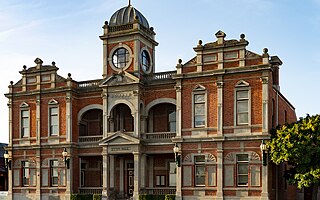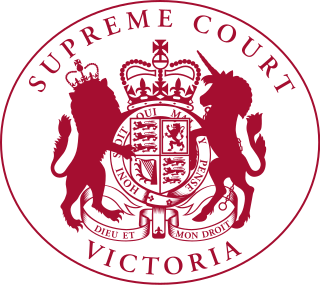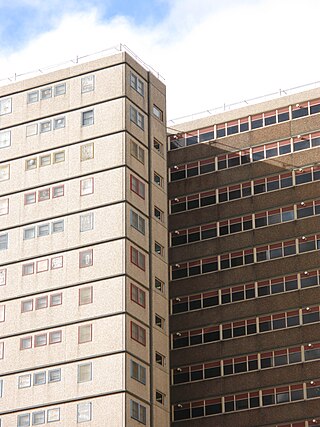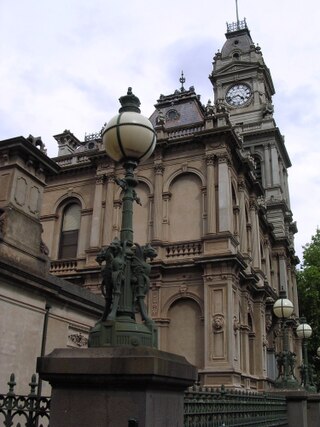
Bendigo is a city in north-central Victoria, Australia, located in the Bendigo Valley near the geographical centre of the state and approximately 150 kilometres (93 mi) north-west of Melbourne, the state capital.

Castlemaine is a town in west central Victoria, Australia, in the Goldfields region about 120 kilometres northwest by road from Melbourne and about 40 kilometres from the major provincial centre of Bendigo. It is the administrative and economic centre of the Shire of Mount Alexander. The population at the 2021 Census was 7,506. Castlemaine was named by the chief goldfield commissioner, Captain W. Wright, in honour of his Irish uncle, Viscount Castlemaine.

Victorian architecture is a series of architectural revival styles in the mid-to-late 19th century. Victorian refers to the reign of Queen Victoria (1837–1901), called the Victorian era, during which period the styles known as Victorian were used in construction. However, many elements of what is typically termed "Victorian" architecture did not become popular until later in Victoria's reign, roughly from 1850 and later. The styles often included interpretations and eclectic revivals of historic styles (see Historicism). The name represents the British and French custom of naming architectural styles for a reigning monarch. Within this naming and classification scheme, it followed Georgian architecture and later Regency architecture and was succeeded by Edwardian architecture.

Kyneton is a town in the Macedon Ranges region of central Victoria, Australia. The Calder Freeway bypasses Kyneton to the north and east. Kyneton is on Dja Dja Wurrung and Taungurung country.

The Old Melbourne Gaol is a former jail and current museum on Russell Street, in Melbourne, Victoria, Australia. It consists of a bluestone building and courtyard, and is located next to the old City Police Watch House and City Courts buildings, and opposite the Russell Street Police Headquarters. It was first constructed starting in 1839, and during its operation as a prison between 1845 and 1924, it held and executed some of Australia's most notorious criminals, including bushranger Ned Kelly and serial killer Frederick Bailey Deeming. In total, 133 people were executed by hanging. Though it was used briefly during World War II, it formally ceased operating as a prison in 1924; with parts of the jail being incorporated into the RMIT University, and the rest becoming a museum.

Bendigo Senior Secondary College (BSSC) is an Australian government-funded co-educational secondary school for Year 11 and Year 12 students located in the centre of Bendigo, Victoria. It is the largest provider of VCE, VCE Vocational Major and VET in the state of Victoria.

The Old Treasury Building on Spring Street in Melbourne was built in 1858-62 in the grand Renaissance Revival style. It was designed to accommodate the Treasury Department, various government officials' offices including the Governor In Council, and basement vaults intended to house gold from the Victorian gold rush. It now houses a range of functions, including a museum of Melbourne history, known as Old Treasury Building Museum.

Sacred Heart Cathedral, Bendigo, is an Australian cathedral. It is the Roman Catholic cathedral church of the Diocese of Sandhurst and seat of Bishop Shane Mackinlay. The cathedral is located in the provincial city of Bendigo, Victoria.

The Supreme Court of Victoria is the highest court in the Australian state of Victoria. Founded in 1852, it is a superior court of common law and equity, with unlimited and inherent jurisdiction within the state.

The Victoria Law Courts is a red brick and terracotta judicial building, which accommodates Birmingham Magistrates' Court, on Corporation Street, Birmingham, England. It is a Grade I listed building.
The Deniliquin railway line is a broad-gauge railway line serving north-western Victoria, Australia. The line runs from the New South Wales town of Deniliquin into Bendigo, before turning south-south-east towards Melbourne, terminating in Docklands near the central business district. It is a major trunk line both for passenger and freight trains, with many lines branching off from it.
Australian non-residential architectural styles are a set of Australian architectural styles that apply to buildings used for purposes other than residence and have been around only since the first colonial government buildings of early European settlement of Australia in 1788.

The Housing Commission of Victoria was a Government of Victoria body responsible for public housing in Victoria, Australia. It was established in 1938, and was abolished in 1984.
The Melbourne City campus of the Royal Melbourne Institute of Technology is located in the city centre of Melbourne in Victoria, Australia. It is sometimes referred to as "RMIT City" and the "RMIT Quarter" of the city in the media.
The architecture of Mumbai blends Gothic, Victorian, Art Deco, Indo-Saracenic & Contemporary architectural styles. Many buildings, structures and historical monuments remain from the colonial era. Mumbai, after Miami, has the second largest number of Art Deco buildings in the world.

The Bendigo Post Office is a building on Pall Mall in Bendigo, a provincial city in the Australian state of Victoria. The post office backs onto and is partly surrounded by Rosalind Park. The building was built between 1883 and 1887 by the contractors McCulloch and McAlpine and designed by Public Works architect George W. Watson in the Second Empire architectural style. The building shares a great deal with its neighbouring building, the Old Bendigo Law Courts Building, and had the same builder and designer and was built at around the same time.

The Shamrock Hotel, currently trading as Hotel Shamrock, is a grand 19th-century hotel in Bendigo, Victoria, Australia, situated on Pall Mall, the city's main street.

The architecture of Melbourne, Victoria, and Australia is characterised by a wide variety of styles. The city is particularly noted for its mix of Victorian architecture and contemporary buildings, with 74 skyscrapers in the city centre, the most of any city in the Southern Hemisphere.

The Supreme Court (Building), is a court building located at 192-228 William Street in Melbourne, Australia. It is part of a complex of buildings which, together with the Supreme Court Library and Court of Appeal, are known as the Melbourne Law Courts. It is currently the home to the Supreme Court of Victoria, the most senior court in the state of Victoria, and inferior only to the High Court of Australia. The Supreme Court has occupied the site since its first sitting in February 1884.

Kerang Post Office is a heritage-listed post office at 51-53 Victoria Street, Kerang, Victoria, Australia. It was designed by the Victorian Colonial Architect, George William Watson, and was built in 1886. It was added to the Australian Commonwealth Heritage List on 8 November 2011.

















